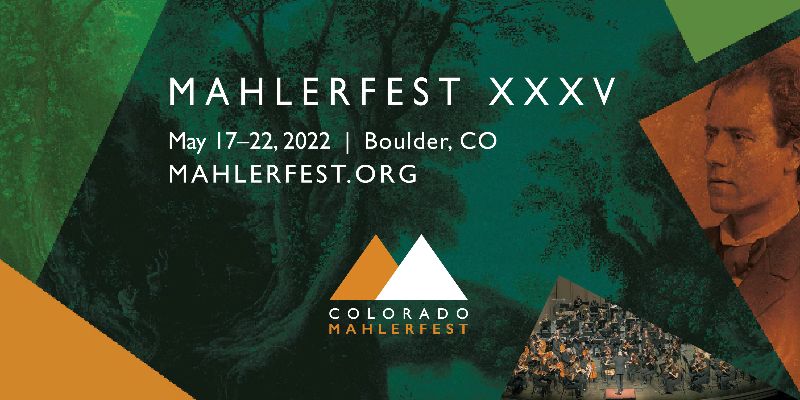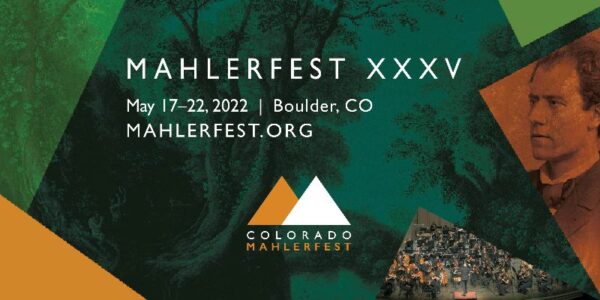It’s that time of year again, when we can feel the rapid approach of Colorado MahlerFest. Here are some of my thoughts about this year’s festival.
The committed Mahlerians in our audience this week will already know that Mahler toyed with the idea of a program for this Third Symphony that looked more or less like this:
- “Pan Awakes, Summer Marches In”
- “What the Flowers in the Meadow Tell Me”
- “What the Animals in the Forest Tell Me”
- “What Mankind Tells Me”
- “What the Angels Tell Me”
- “What Love Tells Me.”
Over the last several months, I’ve been trying to give some thought to the real message behind this program. It’s not hard, for example, to extract a reasonable definition of “What Mankind Tells Me” from the text of Nietzsche’s poem which Mahler sets in this movement. But there is so much more in a movement like that than just the words. And none of these movements are musically self-contained. The fourth movement is built largely around themes from the opening of the first movement. Motives from Mahler’s song, Das himmlische Leben (The Heavenly Life), which would later serve as the Finale of his Fourth Symphony, permeate much of the Third. What does a child’s vision of the culinary pleasures of Heaven have to do with what the animals or the angels have to say?
As I thought about these questions, the scope and vibrancy of Mahler’s vision seemed to grow before my eyes. It seems clear to me that Mahler’s Third Symphony challenges us to rethink two very big things. First, we must re-evaluate how much the flowers in the meadow have to tell us, and, second, what it really means to listen to what they have to say. Taken as an example, it’s not hard to equate the delicately picturesque nature of the music of that movement with the dainty beauty of a field of wildflowers. But, in spite of a carefully crafted level of surface naivete, this is music of supreme sophistication and complexity, similar in length to the last movement of Brahms’s Fourth Symphony. You and I may look at the flowers in the meadow and see color and beauty, but Mahler not only sees that, he hears what they have to say in such depth and with such precision that it takes him 270 measures of symphonic music to communicate that message to us. What would today’s flowers tell us if we listened to them with Mahlerian intensity? Perhaps they might tell us the tale of dwindling biodiversity, or of the worrying disappearance of the bees? These messages are a tale that the flowers of our time are waiting to tell us, if only we will listen.
Likewise the animals in the forest. Often described as one of Mahler’s “intermezzo” movements, this is a huge movement, almost 17 minutes long, music of astonishing craft and imagination. Accept for a moment the idea that every note in these 590 bars is part of the message the animals gave to Mahler. What were they trying to tell him then? What would they tell us now? Would they sorrowfully report that the great forests which Mahler explored is now almost entirely gone? Would they speak of the wolves who vanished since Mahler’s day? Or of birds who used to nest in trees long ago felled?
In Mahler’s vision, when humanity finally speaks, it is as if humankind is finally ready to report what has been heard in the bittersweet words of the flowers and the animals. “What says the deep midnight?” asks Nietzsche. The voice of midnight says, “O Man! Take heed… the world is deep, and deeper than the day has thought. Deep is its pain.” Humankind realizes the cost of not listening to the world around us. “”I slept, I slept —, from a deep dream have I awoken… Pain asks for release.” This movement is about more than humanity’s guilt. It’s the recognition that our failure to listen to the world around us has brought us deep pain. By including “What Mankind Tells Me” in the program, isn’t Mahler reminding us that it is also important to listen deeply and empathetically to what we have to tell each other?
Finally, what does Mahler mean when he offers to convey to us “What Love Tells Me” in the 25 minutes of the Adagio which crowns the most expansive and revolutionary symphony he ever wrote? What does Mahler mean by “love” in this movement? It seems to have little to do with the kind of romantic love he depicts in the Adagietto of his Fifth Symphony, written, in part, as a declaration of his feelings for his future wife, Alma. Many commentators have suggested that love in this context means God. But where does a monotheistic God fit in this symphony’s pantheistic view of creation? How does such a deity coexist with the text of the famous atheist Nietzsche? In Mahler’s vision, what is “love” as both noun and verb, and what does love tell us?
It may be easier to start with love as a noun. Surely, love in the finale tells us about hope: this may be Mahler’s most sublimely hopeful movement. Love tells us about solace, as the reference to Beethoven’s final string quartet makes clear. Love understands that life is full of pain, as when Mahler reminds us of the stormy climax of the first movement, and consoles us with the knowledge that pain helps us to learn, to change and to understand. It is the toll we pay for the road we walk toward enlightenment.
But love is very much a verb, too. What is it to love? Is it not to listen? To hear what the animals, flowers, and people have to tell us? But also to act? Mahler translates the message of love into action by turning the messages, stories, and feelings of the world into music. We can learn so much from understanding the music of each message, but also from studying the musical interconnections between these movements. This web of musical relationships is a powerful metaphor for the connections that bind flora to fauna, humanity to nature. As Mahler listens, so should we strive to listen. And so should we strive to act. Few of us will have his creative genius, but can we not act in other ways? To listen, to care, to act. To love. Mahler has had me thinking a lot about these things these last few months.
We hope you enjoy MahlerFest XXXV.


Bravo Ken!
Mahler’s concept of Love is surely the transcendent unity of all Creation, once the illusion of separateness falls away.
Wishing Mahlerfest all the best for 2022.
Peter Davison
I came to Mahler through #2. Then 4, then 1, then 5. And then I loved them all. But 7 and 3 are the ones I listen to most these days.
It’s my favourite Mahler symphony and as a teenager, I played Tennstedt’s EMI recording of it many times. Forty years on, I view it as a flawed masterpiece – that finale is 10 minutes too long and there’s more repetition than development. But there are so many sublime moments and the experience of entering that Mahlerian world and submitting oneself to his vision is a profound one.
I believe that Mahler’s intimate connection to nature and creation is the golden thread running through all his work and that love is not just human love but love of life. In those gentle closing bars of the 9th it’s as if he cannot bear to bring the music to an end, to bring life to an end. I live close to some very old, crumbling limestone cliffs which seem as old as the earth, so looking at them makes me think of the very opening of the 1st, so simple and musically basic, the very beginning of a blank canvas on which to paint the world. Was it to Bruno Walter or Hugo Wolf, I forget which, to whom he was supposed to have said, when they were looking out at the lake and mountains, “oh, you don’t need to bother looking at that, i’ve composed it all”? As for finding Mahler, I have to admit that I arrived there through Ken Russell’s film, ‘Mahler’, starring Robert Powell in about 1975! For which I am most grateful. Greetings to your festival from Scotland!
God forgive me, but the two passages in Mahler which have always moved me the most are “Der Abschied” in DAS LIED VON DER ERDE, and the Finale of the 10th Symphony…especially the latter. He seems to be consoling us, ahead of time, for the deaths and atrocities we will have lived through over the next century or so. (On a smaller scale, I get the same impression from John Coltrane’s “After the Rain.”)